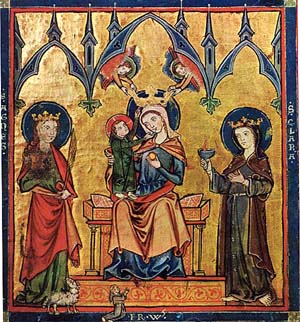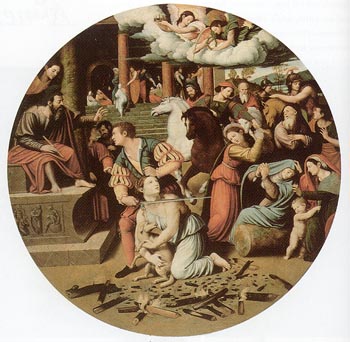 |
The Saint of the Day
St. Agnes, January 21
Prof. Plinio Corrêa de Oliveira
Biographical selection from St. Ambrose, On Virgins, Book II:
St. Ambrose speaks with great admiration of St. Agnes, who was martyred at the tender age of 12. In his work, On Virgins, he wrote: “This is a new kind of martyrdom! One not yet of fit age for punishment, but already ripe for victory. One unready for combat, but able to win the crown. One who has not yet reached the age of judgment but who has mastered virtue ....

Our Lady and the Christ Child with St. Agnes, left, and St. Clare, right
|
“Joyfully she advances with unhesitating step to the place of punishment, her head not adorned with plaited hair, but with Christ. All weep; she alone is without a tear. All wonder that she is so ready to deliver her life, which she has not yet enjoyed, but which now she gives up as though she had lived it fully. All are astounded that she stands forth as God’s witness although at her age she could not yet decide about herself!
"And so it came about that what she said regarding God was believed, although what she said about man would not be accepted. For that which is beyond nature is from the Author of nature. ....
“She stands, she prays, she bends down her neck. You can see the executioner tremble, as though he himself has been condemned. His right hand is shaking, his face grows pale. He fears the peril of another, while the maiden fears not for her own danger.
"You have then in one victim a twofold martyrdom, of chastity and religion. She both remained a virgin and she obtained martyrdom."
Comments of Prof. Plinio:
St. Ambrose’s commentary on St. Agnes has a literary value that is both profound and very beautiful because it is all composed of contrasts. Through the use of these contrasts, St. Ambrose shows the points he wants to emphasize.
First, there is the contrast between her age and the martyrdom. She is too young to be condemned to death because at such a young age no one can deserve such a punishment. And yet she is already ripe for the victory. The one who is not mature in years is nonetheless ripe to win the victory. It is a glory. The immaturity of the years and maturity of the virtue.
The second contrast: She is unready for combat, but ripe for the crown. A young girl at that time did not have any conditions to fight, yet she won the highest of all the laurels, which is the crown of martyrdom.

The death of St. Agnes was a synthesis
of harmonic contrasts
|
The third contrast: She is so young that she is still under the guardianship of others. The law does not consider her capable of governing herself. All present admired her because she was a witness of the Godhead, even though she was still a minor who could not be a witness of anything in a court of human law. Her word would not have any value in a normal process of law, yet she has impressed everyone with her defense of Our Lord.
In addition to this, there are the contrasts that one can find in the actual martyrdom. She advances joyfully, with unhesitating step, to the place from which all people naturally flee.
Another contrast: her adornment is not artificially plaited tresses but rather Jesus Christ, because He is the true adornment, the real beauty of the soul who consecrates itself to Him.
Another contrast: she is not crowned with flower wreaths like the other young Roman girls of her time, but with purity. That purity in her is splendorous and makes a kind of halo around her head.
There are still other contrasts. All are weeping to see a young girl who will be killed. But she is not. It is a glorious contrast, because she is thirsting for Heaven, and not for earth. Along those lines, everyone is astonished that she can so easily give up a life that has hardly begun. Yet she sacrifices this life as if she had already lived and enjoyed it fully.
And what is the reason for all these contrasts? It is because St. Ambrose is trying to emphasize that there is something absurd in her martyrdom. For it would be natural for her to do the very opposite of what she is doing. The reason that she acts as she does with a strength that is beyond nature is because such strength can only come from the Author of nature itself. What is beyond nature is what is more than the merely natural. What is more than nature here is the One who is its author. God revealed Himself in the sanctity of St. Agnes and in the miracle of her death.
She goes forward and bends her head. She sees the executioner trembling as if he were the one who was condemned. But she – the condemned one – is calm and steady.
His right hand is shaking, his face pale. He fears the peril of another, while the maiden fears not for her own danger. The executioner trembles with fear to use the tools of punishment. But she has no fear of the executioner.
You have then in one victim a twofold martyrdom, of chastity and religion. She both remained a virgin and she obtained martyrdom.
This is the magnificent commentary of St. Ambrose on St. Agnes.


  |
| Prof. Plinio Corrêa de Oliveira |
|
The Saint of the Day features highlights from the lives of saints based on comments made by the late Prof. Plinio Corrêa de Oliveira. Following the example of St. John Bosco who used to make similar talks for the boys of his College, each evening it was Prof. Plinio’s custom to make a short commentary on the lives of the next day’s saint in a meeting for youth in order to encourage them in the practice of virtue and love for the Catholic Church. TIA thought that its readers could profit from these valuable commentaries.
The texts of both the biographical data and the comments come from personal notes taken by Atila S. Guimarães from 1964 to 1995. Given the fact that the source is a personal notebook, it is possible that at times the biographic notes transcribed here will not rigorously follow the original text read by Prof. Plinio. The commentaries have also been adapted and translated for TIA’s site.
|
Saint of the Day | Home | Books | CDs | Search | Contact Us | Donate

© 2002- Tradition in Action, Inc. All Rights Reserved
|
 |
|